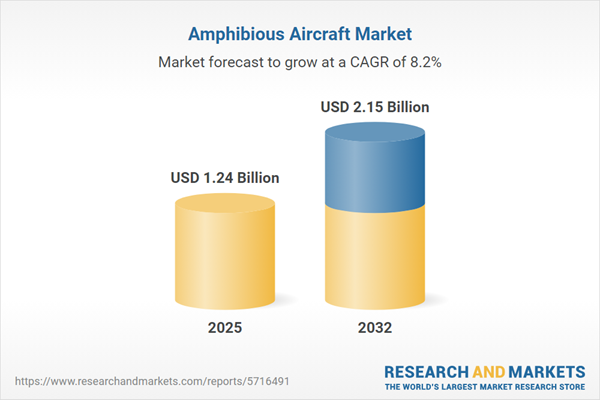Speak directly to the analyst to clarify any post sales queries you may have.
Amphibious aircraft are steadily reshaping operational strategies for organizations prioritizing agility and technological advancement. For senior decision-makers, effective adoption of these platforms offers a route to heightened adaptability and risk management in dynamic regulatory and mission environments.
Market Snapshot: Amphibious Aircraft Market Growth and Opportunity
The amphibious aircraft market continues to gain momentum, with current valuation at USD 1.15 billion in 2024 and projected to reach USD 1.24 billion by 2025. Long-term expansion forecasts show the market achieving USD 2.15 billion by 2032, with a robust CAGR of 8.18%. This direction is a result of increasing requirements for highly adaptable aircraft capable of transitioning between terrestrial and aquatic operations. Sectors such as firefighting, maritime surveillance, and commercial transport are intensifying their procurement of amphibious platforms to improve operational reach and resilience. Meanwhile, advances in materials science and digitalization are recasting investment and innovation goals for market participants navigating shifting industry benchmarks.
Scope & Segmentation
- End Use: Emergency response, firefighting, maritime patrol, tourism, search and rescue, cargo transportation, and passenger transit support both governmental and civil stakeholders, ensuring operational agility in mission-critical scenarios.
- Propulsion Type: Multi-engine, single-engine piston models, and turboprops enable broad mission selection, balancing performance with cost targets for diverse operators.
- Platform Type: Floatplanes with single or twin floats and flying boats with catamaran or conventional hull designs deliver flexibility for operations across rivers, lakes, and coastal zones.
- Seating Capacity: Ultra-light and light models address general aviation needs, with medium and heavy classes tailored for regional passenger flows and specialized logistics applications.
- Geographic Regions: The Americas, Europe, Middle East & Africa, and Asia-Pacific drive sector growth, reflecting varying levels of infrastructural maturity, compliance obligations, and targeted application use-cases.
- Key Technologies: Composite hulls, advanced propulsion systems, modular payload integration, adaptive sensors, and digital health monitoring systems all contribute to aircraft performance and lifecycle efficiency.
- Companies Covered: Notable participants include ShinMaywa Industries, Viking Air Limited, Textron Aviation, ICON Aircraft, Progressive Aerodyne, Seamax Aircraft, Lake Aircraft, Evektor-Aerotechnik, Dornier Seawings, and Air Tractor, each influencing global market trends.
Key Takeaways for Senior Decision-Makers
- Integrating cutting-edge materials and propulsion enhances operational dependability while supporting flexible fleet composition for multiple mission requirements.
- Adoption of modular payload and sensor systems maximizes aircraft utility and allows functionality enhancements without requiring new platforms.
- Regional differences in infrastructure and application demand compel tailored procurement and deployment strategies for optimal resource allocation.
- Prioritizing compliance, certification, and after-market service support increases asset lifespan and ensures consistent deployment readiness.
- Close collaboration with manufacturers, regulators, and research organizations can streamline innovation cycles and foster faster adoption of next-generation models.
- Digital planning and predictive analysis further strengthen preparedness, allowing organizations to respond proactively to regulatory updates and evolving operational priorities.
Tariff Impact on Product Sourcing and Manufacturing
Recent US-imposed tariffs on essential components such as aerostructures, propulsion systems, and avionics are prompting strategic adjustments within the amphibious aircraft supply chain. Manufacturers are turning toward domestic suppliers to alleviate increased costs and mitigate risks associated with international trade disruptions. Businesses with historic reliance on overseas partnerships are emphasizing local alliances to boost supply chain stability. Domestic incentive programs and revised tax policies are encouraging more cohesive collaboration across airframe, propulsion, and maintenance sectors, enhancing the industry's resilience to future trade shifts.
Methodology & Data Sources
Findings are developed from direct interviews with engineers, regulatory specialists, and principal users, supported by rigorous reviews of technical documentation and case analyses. The methodology includes benchmarking and tailored record validations, delivering a reliable perspective on sector-wide technological change and supply chain development.
Why This Report Matters for Amphibious Aircraft Market Leaders
- Enables executive teams to align strategic direction, procurement, and growth trajectories with immediate and long-term market opportunities.
- Provides actionable, segmented intelligence on key technology trends, operational requirements, and global market shifts for informed decision-making.
- Delivers comprehensive risk management guidance to anticipate partnership, compliance, and supply chain challenges in evolving environments.
Conclusion
This report condenses the complexity of the amphibious aircraft sector into actionable guidance. Leverage these analyses to strengthen risk management, unlock operational opportunities, and position your organization for sustainable growth.
Additional Product Information:
- Purchase of this report includes 1 year online access with quarterly updates.
- This report can be updated on request. Please contact our Customer Experience team using the Ask a Question widget on our website.
Table of Contents
3. Executive Summary
4. Market Overview
7. Cumulative Impact of Artificial Intelligence 2025
List of Figures
Samples

LOADING...
Companies Mentioned
The key companies profiled in this Amphibious Aircraft market report include:- ShinMaywa Industries, Ltd.
- Viking Air Limited
- Textron Aviation Inc.
- ICON Aircraft, Inc.
- Progressive Aerodyne, Inc.
- Seamax Aircraft Ltd.
- Lake Aircraft, Inc.
- Evektor-Aerotechnik, a.s.
- Dornier Seawings GmbH
- Air Tractor, Inc.
Table Information
| Report Attribute | Details |
|---|---|
| No. of Pages | 193 |
| Published | October 2025 |
| Forecast Period | 2025 - 2032 |
| Estimated Market Value ( USD | $ 1.24 Billion |
| Forecasted Market Value ( USD | $ 2.15 Billion |
| Compound Annual Growth Rate | 8.1% |
| Regions Covered | Global |
| No. of Companies Mentioned | 11 |









